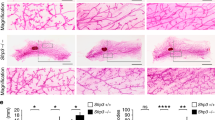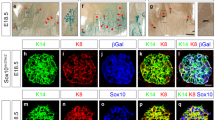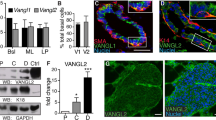Key Points
-
Mammary glands are the defining feature of mammals. They develop as derivatives of the ventral skin, along two symmetrical lines along the ventral surface of the embryo.
-
Initiation of the epithelial bud and ductal outgrowth is coordinated through short-range signalling between epithelium and mesenchyme. Studies of natural and induced mouse mutants in which early mammary development is perturbed have identified genetic networks that regulate specific steps in this process.
-
Research in early mammary development is largely aimed at: understanding how mammary cell identity is determined; identifying the signals that induce the development of the mammary bud precursors in reproducible positions along the body axes, and mediate the exchange between epithelium and mesenchyme; and establishing which downstream targets transmit these signals.
-
The site where future mammary glands develop is called the milk line. Factors such as fibroblast growth factor (FGF), wingless-related MMTV integration site (WNT) and neuregulin 3 (NRG3), which emanate from somites and the lateral mesoderm, form gradients that determine the position of the milk line.
-
Cells in the milk line assume mammary cell identity and form small placodes that develop into buds that elongate and sprout into a ductal tree.
-
The transcription factors lymphoid enhancer-binding factor 1 (LEF1) and T-box 3 (TBX3) are required for placode development. In the absence of these proteins milk-line-specific gene expression is induced but further development is arrested.
-
Mammary epithelial cells in the placode induce the formation of mammary mesenchyme cells in their vicinity by signalling through the parathyroid hormone-like hormone (PTHLH). These mesenchymal cells promote mammary cell identity.
-
Mammary epithelial cells maintain their identity by suppressing hedgehog signalling that is mediated by Gli-Kruppel family member 3 (GLI3). Initiation of hedgehog signalling causes mammary epithelial cells to revert to an epidermal fate.
-
Ductal outgrowth requires the activities of PTHLH and RASGRF1 (Ras protein-specific guanine-releasing factor 1). Bone morphogenetic protein 4 (BMP4) and insulin-like growth factor 1 (IGF1) mediate this process.
-
Many of the signalling pathways that are involved in early mammary gland development are deregulated in breast cancer and in other disorders. A better understanding of the role of these pathways in normal development will therefore be of great importance for understanding many human diseases.
Abstract
Mammary glands become functional only in adult life but their development starts in the embryo. Initiation of the epithelial bud and ductal outgrowth are coordinated through short-range signals between epithelium and mesenchyme. Studies of natural and induced mouse mutants in which early mammary development is perturbed have identified genetic networks that regulate specific steps in these processes. Some of these signals contribute to aberrant mammary development in humans and are deregulated in cancer.
This is a preview of subscription content, access via your institution
Access options
Subscribe to this journal
Receive 12 print issues and online access
$189.00 per year
only $15.75 per issue
Buy this article
- Purchase on Springer Link
- Instant access to full article PDF
Prices may be subject to local taxes which are calculated during checkout




Similar content being viewed by others
References
Balinsky, B. I. On the prenatal growth of the mammary gland rudiment in the mouse. J. Anat. 84, 227–235 (1950).
Robinson, G. W. Identification of signaling pathways in early mammary gland development by mouse genetics. Breast Cancer Res. 6, 105–108 (2004).
Bamshad, M. et al. Mutations in human TBX3 alter limb, apocrine and genital development in ulnar-mammary syndrome. Nature Genet. 16, 311–315 (1997).
Tumpel, S. et al. Regulation of Tbx3 expression by anteroposterior signalling in vertebrate limb development. Dev. Biol. 250, 251–262 (2002).
Wysolmerski, J. J. et al. Absence of functional type 1 parathyroid hormone (PTH)/PTH-related protein receptors in humans is associated with abnormal breast development and tooth impaction. J. Clin. Endocrinol. Metab. 86, 1788–1794 (2001).
Kere, J. et al. X-linked anhidrotic (hypohidrotic) ectodermal dysplasia is caused by mutation in a novel transmembrane protein. Nature Genet. 13, 409–416 (1996).
Monreal, A. W. et al. Mutations in the human homologue of mouse dl cause autosomal recessive and dominant hypohidrotic ectodermal dysplasia. Nature Genet. 22, 366–369 (1999).
Laurikkala, J. et al. Regulation of hair follicle development by the TNF signal ectodysplasin and its receptor Edar. Development 129, 2541–2553 (2002).
Mustonen, T. et al. Stimulation of ectodermal organ development by Ectodysplasin-A1. Dev. Biol. 259, 123–136 (2003).
Howard, B. A. & Gusterson, B. A. Mammary gland patterning in the AXB/BXA recombinant inbred strains of mouse. Mech. Dev. 91, 305–309 (2000).
Howard, B. A. & Gusterson, B. A. The characterization of a mouse mutant that displays abnormal mammary gland development. Mamm. Genome 11, 234–237 (2000).
Howard, B., Panchal, H., McCarthy, A. & Ashworth, A. Identification of the scaramanga gene implicates Neuregulin3 in mammary gland specification. Genes Dev. 19, 2078–2090 (2005).
Howard, B. & Ashworth, A. Signalling pathways implicated in early mammary gland morphogenesis and breast cancer. PLoS Genet. 2, 1112–1130 (2006).
Foley, J. et al. Parathyroid hormone-related protein maintains mammary epithelial fate and triggers nipple skin differentiation during embryonic breast development. Development 128, 513–525 (2001).
Veltmaat, J. M., Van Veelen, W., Thiery, J. P. & Bellusci, S. Identification of the mammary line in mouse by Wnt10b expression. Dev. Dyn. 229, 349–356 (2004).
DasGupta, R. & Fuchs, E. Multiple roles for activated LEF/TCF transcription complexes during hair follicle development and differentiation. Development 126, 4557–4568 (1999).
Cheon, S. S. et al. β-Catenin stabilization dysregulates mesenchymal cell proliferation, motility, and invasiveness and causes aggressive fibromatosis and hyperplastic cutaneous wounds. Proc. Natl Acad. Sci. USA 99, 6973–6978 (2002).
Chu, E. Y. et al. Canonical WNT signaling promotes mammary placode development and is essential for initiation of mammary gland morphogenesis. Development 131, 4819–4829 (2004). Shows that WNT signals are involved in specifying the milk line and mammary placodes.
van Genderen, C. et al. Development of several organs that require inductive epithelial-mesenchymal interactions is impaired in LEF-1-deficient mice. Genes Dev. 8, 2691–2703 (1994). Shows that the absence of LEF1 inhibits the development of epidermal appendages, and implicates the WNT pathway in their development.
Boras-Granic, K., Chang, H., Grosschedl, R. & Hamel, P. A. Lef1 is required for the transition of Wnt signaling from mesenchymal to epithelial cells in the mouse embryonic mammary gland. Dev. Biol. 295, 219–231 (2006).
Mailleux, A. A. et al. Role of FGF10/FGRR2b signaling during mammary gland development in the mouse embryo. Development 129, 53–60 (2002).
Veltmaat, J. M. et al. Gli3-mediated somitic Fgf10 expression gradients are required for the induction and patterning of mammary epithelium along the embryonic axes. Development 133, 2325–2335 (2006). Shows that FGF10 that is produced by the somites induces the milk line and that the level of this protein determines the position of the line.
Jerome-Majewska, L. A. et al. Tbx3, the ulnar-mammary syndrome gene, and Tbx2 interact in mammary gland development through a p19Arf/p53-independent pathway. Dev. Dyn. 234, 922–933 (2005).
Eblaghie, M. C. et al. Interactions between FGF and Wnt signals and Tbx3 gene expression in mammary gland initiation in mouse embryos. J. Anat. 205, 1–13 (2004).
Hatsell, S. J. & Cowin, P. Gli3-mediated repression of Hedgehog targets is required for normal mammary development. Development 133, 3661–3670 (2006). References 25 and 30 show that repression of hedgehog signalling is required to maintain the identity of mammary epithelial cells.
Davenport, T. G., Jerome-Majewska, L. A. & Papaioannou, V. E. Mammary gland, limb and yolk sac defects in mice lacking Tbx3, the gene mutated in human ulnar mammary syndrome. Development 130, 2263–2273 (2003). Reports that deletion of Tbx3 in mice results in similar lesions to those found in humans, and identifies TBX3 as being an important signalling molecule in mammary development.
Cho, K. W. et al. Molecular interactions between Tbx3 and Bmp4 and a model for dorsoventral positioning of mammary gland development. Proc. Natl Acad. Sci. USA 103, 16788–16793 (2006).
Rallis, C., Del Buono, J. & Logan, M. P. Tbx3 can alter limb position along the rostrocaudal axis of the developing embryo. Development 132, 1961–1970 (2005).
Aza-Blanc, P., Lin, H. Y., Ruiz i Altaba, A. & Kornberg, T. B. Expression of the vertebrate Gli proteins in Drosophila reveals a distribution of activator and repressor activities. Development 127, 4293–4301 (2000).
Gritli-Linde, A. et al. Abnormal hair development and apparent follicular transformation to mammary gland in the absence of hedgehog signaling. Dev. Cell 12, 99–112 (2007).
Robinson, G. W., Karpf, A. B. & Kratochwil, K. Regulation of mammary gland development by tissue interaction. J. Mammary Gland Biol. Neoplasia 4, 9–19 (1999).
Heuberger, B., Fitzka, I., Wasner, G. & Kratochwil, K. Induction of androgen receptor formation by epithelium-mesenchyme interaction in embryonic mouse mammary gland. Proc. Natl Acad. Sci. USA 79, 2957–2961 (1982). Provides the first evidence that epithelial signals induce mammary mesenchyme cell identity.
Dunbar, M. E. et al. Parathyroid hormone-related protein signaling is necessary for sexual dimorphism during embryonic mammary development. Development 126, 3485–3493 (1999). Reports the identification of PTHLH as the epithelial factor that induces the mammary mesenchyme.
Dunbar, M. E. & Wysolmerski, J. J. Parathyroid hormone-related protein: a developmental regulatory molecule necessary for mammary gland development. J. Mammary Gland Biol. Neoplasia 4, 21–34 (1999).
Wysolmerski, J. J. et al. Rescue of the parathyroid hormone-related protein knockout mouse demonstrates that parathyroid hormone-related protein is essential for mammary gland development. Development 125, 1285–1294 (1998).
Zhang, J. et al. Dissection of promoter control modules that direct Bmp4 expression in the epithelium-derived components of hair follicles. Biochem. Biophys. Res. Commun. 293, 1412–1419 (2002).
Hens, J. R. et al. BMP4 and PTHrP interact to stimulate ductal outgrowth during embryonic mammary development and to inhibit hair follicle induction. Development 134, 1221–1230 (2007).
Satokata, I. et al. Msx2 deficiency in mice causes pleiotropic defects in bone growth and ectodermal organ formation. Nature Genet. 24, 391–395 (2000).
Heckman, B. M. et al. Crosstalk between the p190-B RhoGAP and IGF signaling pathways is required for embryonic mammary bud development. Dev. Biol. 309, 137–149 (2007).
Chakravarty, G., Hadsell, D., Buitrago, W., Settleman, J. & Rosen, J. M. p190-B RhoGAP regulates mammary ductal morphogenesis. Mol. Endocrinol. 17, 1054–1065 (2003).
Stingl, J. et al. Purification and unique properties of mammary epithelial stem cells. Nature 439, 993–997 (2006).
Shackleton, M. et al. Generation of a functional mammary gland from a single stem cell. Nature 439, 84–88 (2006). References 41 and 42 describe the isolation of mammary stem cells and show that the entire mammary epithelium can be reconstituted from a single cell.
Katz, E. & Streuli, C. H. The extracellular matrix as an adhesion checkpoint for mammary epithelial function. Int. J. Biochem. Cell Biol. 39, 715–726 (2007).
Li, N. et al. Beta1 integrins regulate mammary gland proliferation and maintain the integrity of mammary alveoli. EMBO J. 24, 1942–1953 (2005).
Naylor, M. J. et al. Ablation of beta1 integrin in mammary epithelium reveals a key role for integrin in glandular morphogenesis and differentiation. J. Cell Biol. 171, 717–28 (2005).
Asselin-Labat, M. L. et al. Gata-3 is an essential regulator of mammary-gland morphogenesis and luminal-cell differentiation. Nature Cell Biol. 9, 201–209 (2007).
Kouros-Mehr, H., Slorach, E. M., Sternlicht, M. D. & Werb, Z. GATA-3 maintains the differentiation of the luminal cell fate in the mammary gland. Cell 127, 1041–1055 (2006). References 46 and 47 show that GATA3, which is mutated in many breast cancers, is also required for placode formation in the embryo and for the development of luminal cells in the adult.
Kratochwil, K. Development and loss of androgen responsiveness in the embryonic rudiment of the mouse mammary gland. Dev. Biol. 61, 358–365 (1977).
Robinson, G. W., Accili, D. & Hennighausen, L. Rescue of mammary epithelium of early lethal phenotypes by embryonic mammary gland transplantation as exemplified with insulin receptor null mice. In Methods in Mammary Gland Biology and Breast Cancer Research (eds. Ip, M. M. & Asch, B. B.) 307–316 (Kluwer Academic/Plenum Publishers, New York, 2000).
DeOme, K. B., Faulkin, L. J. Jr., Bern, H. A. & Blair, P. B. Development of mammary tumors from hyperplastic alveolar nodules transplanted into gland-free mammary fat pads of female C3H mice. Cancer Res. 19, 515–520 (1959).
Raynaud, A. Effect des injections d'hormones sexuelles a la souris gravide, sur le developpement des ebauches de la glande mammaire des embryons. I. Action des substances androgene. Ann. Endocrinol. 8, 248–253 (1947) (in French).
Wasner, G., Hennermann, I. & Kratochwil, K. Ontogeny of mesenchymal androgen receptors in the embryonic mouse mammary gland. Endocrinology 113, 1771–1780 (1983).
Kratochwil, K. & Schwartz, P. Tissue interaction in androgen response of embryonic mammary rudiment of mouse: identification of target tissue for testosterone. Proc. Natl Acad. Sci. USA 73, 4041–4044 (1976).
Drews, U. & Drews, U. Regression of mouse mammary-gland anlagen in recombinants of Tfm and wild-type tissues: testosterone acts via mesenchyme. Cell 10, 401–404 (1977).
Acknowledgements
The author is supported by the intramural programme of The National Institute of Diabetes and Digestive and Kidney Diseases (NIDDK) of the National Institutes of Health (NIH).
Author information
Authors and Affiliations
Related links
Related links
DATABASES
OMIM
FURTHER INFORMATION
Glossary
- Ectoderm
-
The outer germ layer that covers the early embryo.
- Mesenchyme
-
The layer of embryonic connective tissue that lies between the endoderm and the ectoderm. It gives rise to connective tissue, muscles and skeletal structures.
- Anlage
-
The embryonic rudiment of an organ.
- Placode
-
A lens-shaped thickening of the surface ectoderm that is the precursor of the mammary bud.
- Ulnar mammary syndrome
-
A developmental disorder that is characterized by abnormalities in limbs and apocrine glands.
- Primary sprout
-
A short duct that is formed when the mammary bud elongates at the tip and pushes through the mammary mesenchyme.
- Hypohidrotic ectodermal dysplasias
-
A group of diseases that are characterized by defects in the development of the ectoderm; they affect skin, hair, teeth, nails and apocrine glands.
- Mammary mesenchyme
-
A layer of mesenchymal cells that surround the mammary bud.
- Axilla
-
The junction between forelimb and main body.
- Mammary or milk line
-
A region along the flank of the embryo that shows responsiveness to form mammary placodes when it is exposed to inducing signals.
- Fat pad
-
The stromal compartment of the mammary gland; it is composed of adipocytes and fibroblasts.
- Planar cell polarity
-
The coordinated organization of cells within the plane of a single layer of cells.
- Somite
-
Aggregates of mesodermal cells that are positioned on both sides of the neural tube in the early embryo. They give rise to the vertebrae, skeletal muscle and the dermis (the layer of connective tissue that underlies the epidermis).
- Dermamyotome
-
The part of the somite that develops into dermis and muscle.
- Haploinsufficiency
-
A gene dosage effect that occurs when a diploid requires both functional copies of a gene for a wild-type phenotype. An organism that is heterozygous for a haploinsufficient locus does not have a wild-type phenotype.
- Penetrance
-
The proportion of individuals with a specific genotype who manifest the genotype at the phenotypic level. If penetrance of a disease allele is 100% then all individuals carrying that allele will express the associated disorder.
- Humoral hypercalcaemia of malignancy
-
The presence of a high concentration of calcium ions in the blood of cancer patients.
- Cell autonomous
-
The effect of a mutation is said to be cell autonomous when it affects the cell in which the mutated gene is expressed.
Rights and permissions
About this article
Cite this article
Robinson, G. Cooperation of signalling pathways in embryonic mammary gland development. Nat Rev Genet 8, 963–972 (2007). https://doi.org/10.1038/nrg2227
Issue Date:
DOI: https://doi.org/10.1038/nrg2227
This article is cited by
-
Re-evaluation of the myoepithelial cells roles in the breast cancer progression
Cancer Cell International (2022)
-
Genome-wide association analyses identify known and novel loci for teat number in Duroc pigs using single-locus and multi-locus models
BMC Genomics (2020)
-
In-depth proteome analysis of more than 12,500 proteins in buffalo mammary epithelial cell line identifies protein signatures for active proliferation and lactation
Scientific Reports (2020)
-
Mammary Organoids and 3D Cell Cultures: Old Dogs with New Tricks
Journal of Mammary Gland Biology and Neoplasia (2020)
-
Early lineage segregation of multipotent embryonic mammary gland progenitors
Nature Cell Biology (2018)



